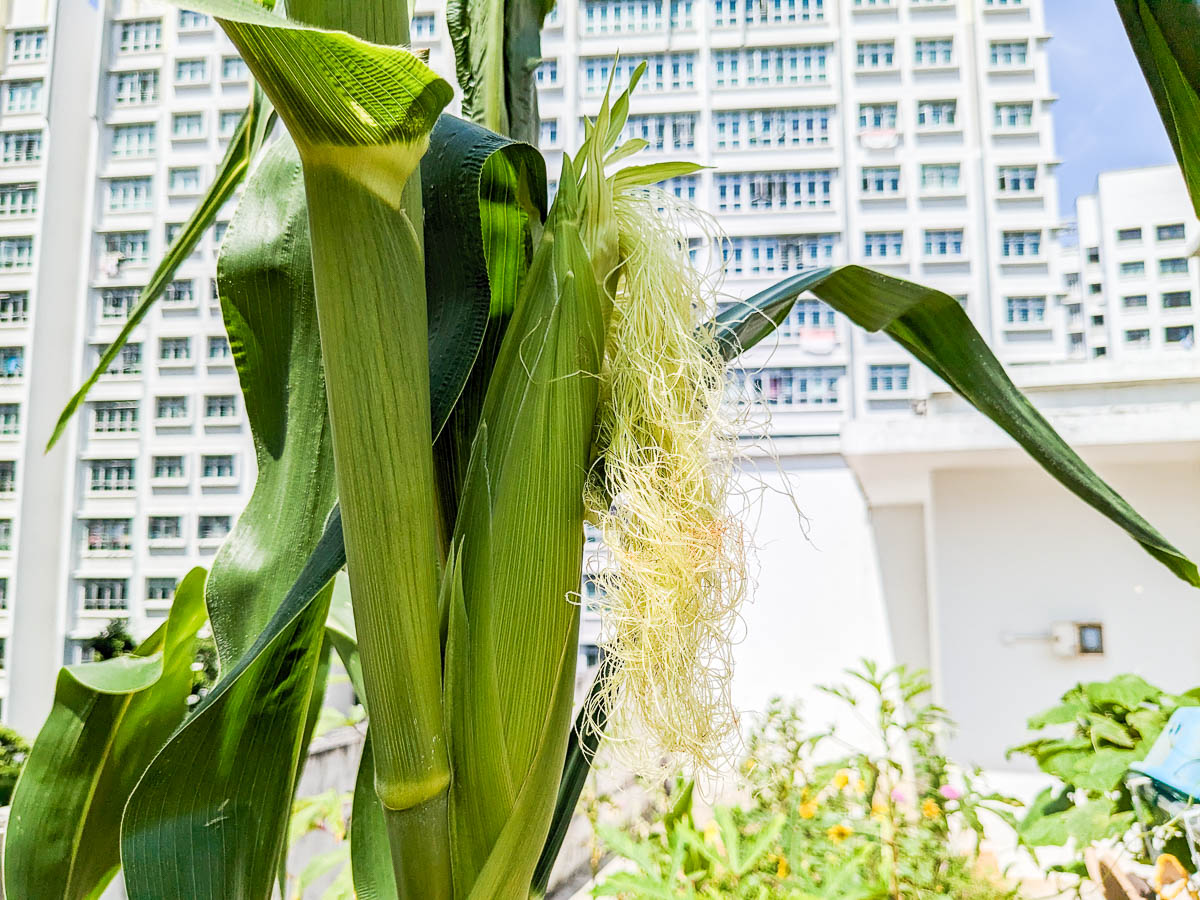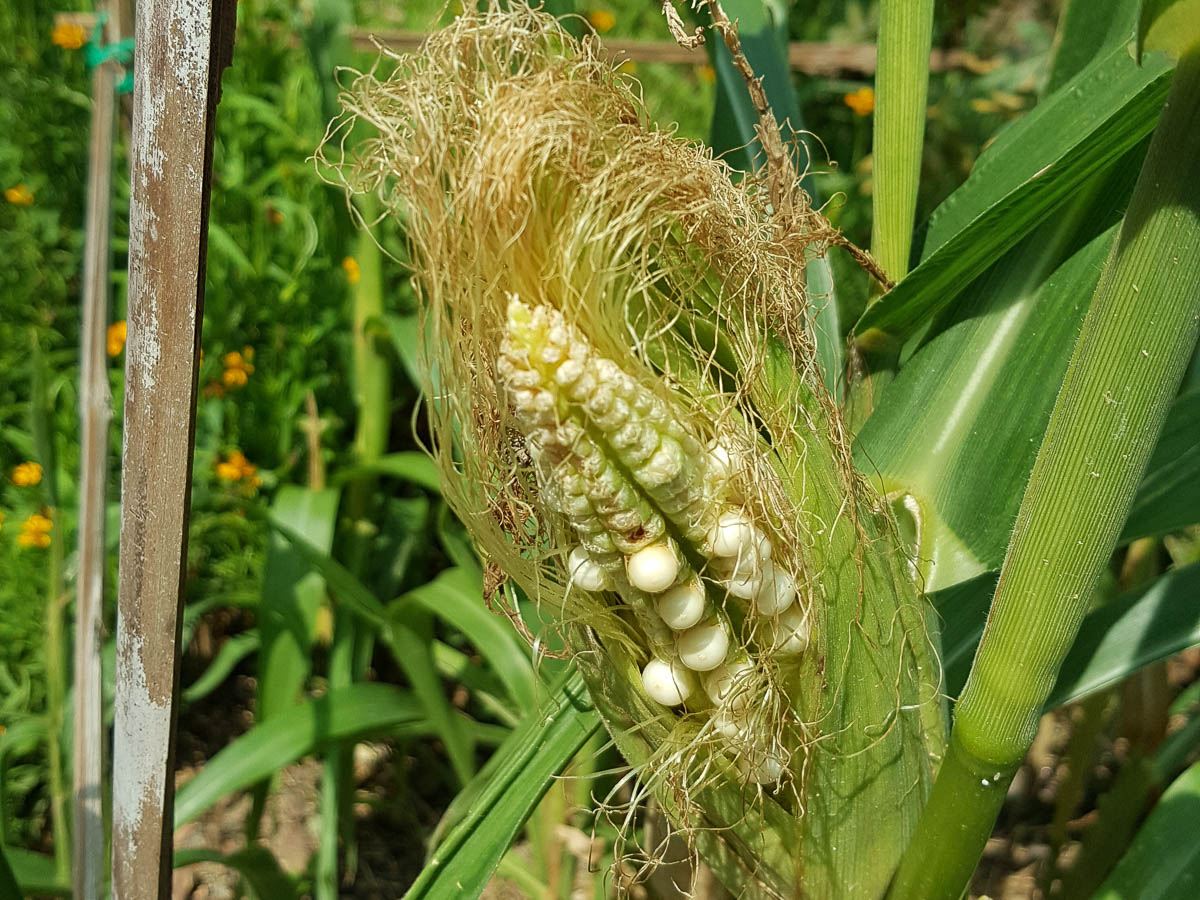Corn
Corn (Zea mays)
Other common names: Maize, Sweet Corn, Jagung, 玉米, 玉蜀黍
.jpg)
Corn is a large and important grain that can create interest for large edible gardens. Because it is wind-pollinated, it is traditionally grown in large numbers close together so that wind-borne pollen can reach more ears on neighbouring plants. They can be grown in pots, but this is usually quite impractical as multiple corn plants are required for pollination. Most common corn varieties are yellow, but there are also cultivars with white, purple, or multi-coloured kernels. Immature and mature corn is versatile and can be eaten in a wide variety of ways. It is most commonly eaten raw, roasted, in soup, as a flour, or as a syrup.
Corn is an annual crop and will need to be cut down after it stops producing.
Sun and soil needs:
.jpg)
This plant does best in full sun gardens with a minimum of 6-8 hours of direct sunlight. It can be grown in gardens with 6 or more hours of indirect sunlight, but the plants may grow slower and produce less fruits.
Plants do best in pots with loamy soil at least 20cm deep, or in true ground. These plants are vulnerable to heat stress and wilting, so keep your plants cool with mulch and plenty of water during dry and hot seasons to encourage growth.
Sowing seeds:
Seeds should be be sown directly into pots or the ground around 15-30cm apart. Lightly water the soil until damp, once a day. The seeds are vulnerable to being eaten by rodents and birds and should be protected with a DIY cloche or netting. Directly sowing corn is preferable as it does not transplant well.
Seeds should sprout in less than a week.
Growing:

Corn is a heavy feeder, and will need fertilisers to produce higher yields. Plants can be fertilised once every two weeks with balanced fertilisers after they germinate to promote leaf and stem growth. After they produce their first flower, swap to fertilisers high in phosphorus and potassium.
Corn is wind-pollinated and will need other corn plants nearby for pollination. Corn can be planted in squares of at least 9 plants to fertilise more ears. Corn can also be hand-pollinated for fuller ears. Regularly tapping the top or shaking the plant to shake pollen off its tassels onto the silks of unripe ears of corn also help with pollination.
It is a good practice to prune regularly and remove dead leaves and stems to improve ventilation and allow light to reach more of the plant. Regular pruning also decreases the likelihood of pests quickly taking over the plant.
Most corn varieties are around 1.5-2m tall, but some cultivars can grow up to 4m tall and may be vulnerable to snapping if the stem is weak. Plants can be supported with stakes if they are in windy areas or exposed to turbulent weather.
Harvesting:
.jpg)
Plants can be harvested for ripe ears around three months after sowing. The best time to harvest the fruit is in the early morning, before 9am.
Immature ears of corn can be harvested and eaten. Immature ears will have lush, green tassels.
Mature ears of corn will have brown and dry tassels, and the kernels should be plump and full of liquid.
Harvest cycle:
| Growing period | Sowing to germination | Germination to transplanting | Transplanting to first harvest | Total sowing to first harvest |
|---|---|---|---|---|
| Approximate time | Less than a week | 1 to 2 weeks | 2 to 6 months | 3 to 6 months |
Check out our sowing and harvest planner to schedule your growing!
Propagation:
Corn is grown from seeds.
Common problems & solutions:
If your plant has little to no flowers, you try fertilising the plant with fertilisers high in phosphorus and potassium. These nutrients encourage root and flower growth, which are important for the plant to produce more fruit.

Ears of corn with “missing” kernels are not fully pollinated. Hand-pollinate your corn by shaking pollen directly onto the corn silks to encourage more kernels to form. Planting corn in dense blocks will increase the rate of pollination as pollen from nearby plants are more likely to land on corn silks.
Aphids, Mealy Bugs, Whiteflies, and Spider Mites often infest the plant if it has underlying problems like repeated wilting from heat stress. Mechanical pest control methods like pruning the infested parts are the best methods for managing these pests in the short term, but resolving the underlying problem will prevent them in the long term.
Corn can become infested with beetle larvae that bore into the stem or fruits. Physically remove the grubs and affected plant parts and regularly check the plant for infestations.
Birds and rodents are attracted to ripe fruit and freshly planted seeds. Protect the plant with netting.

